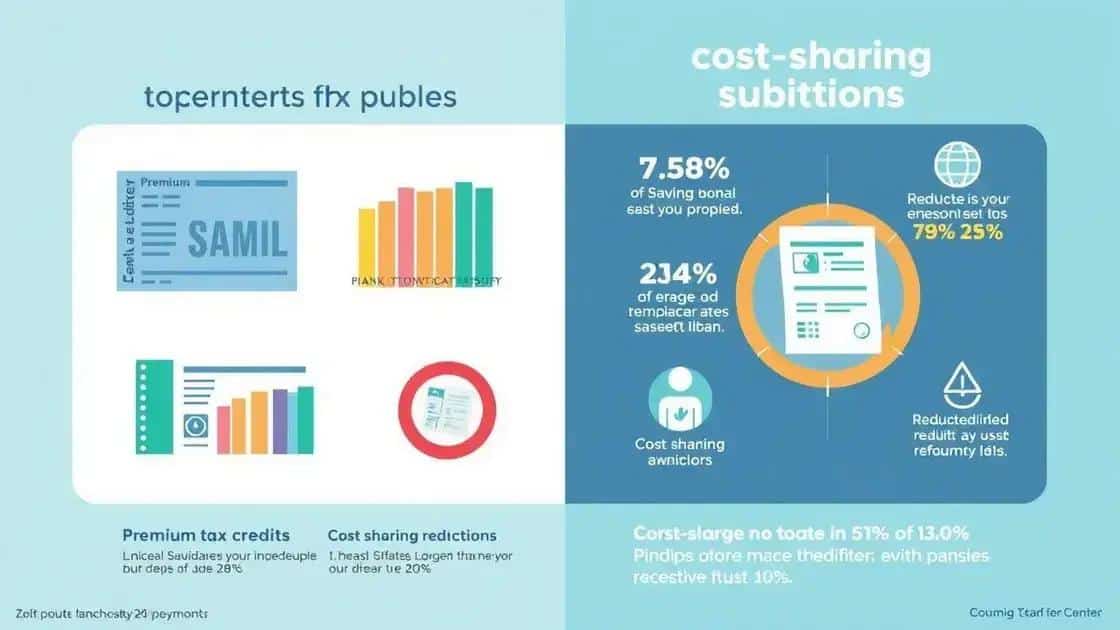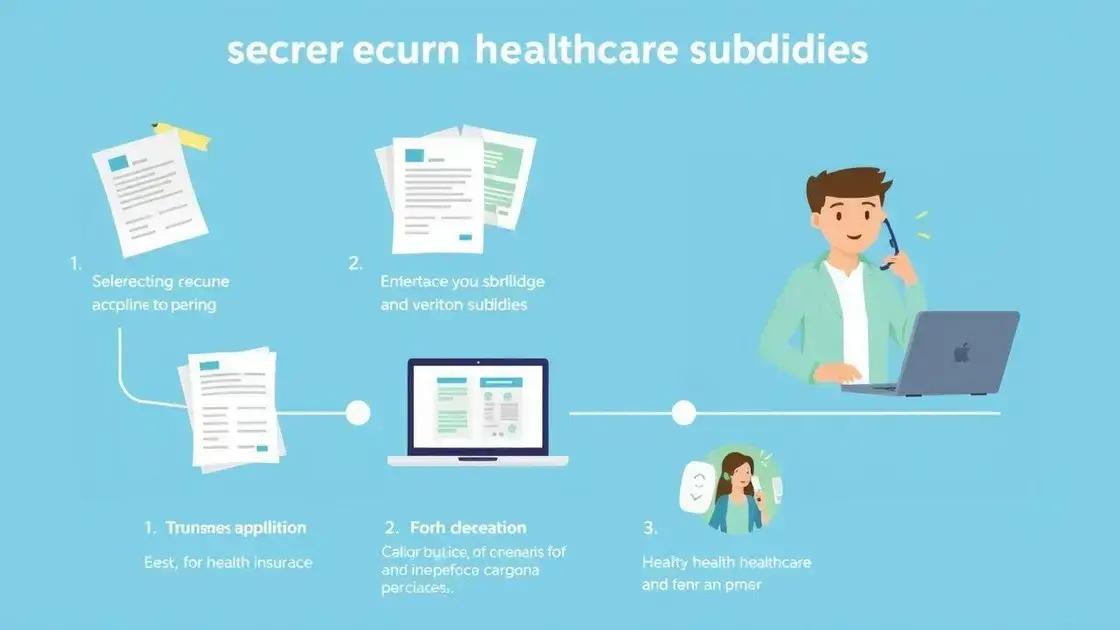Healthcare subsidies: unlocking benefits for everyone

Anúncios
Healthcare subsidies are financial aids from the government that help individuals and families afford health insurance and necessary medical care, significantly improving access to healthcare services.
Healthcare subsidies are crucial for ensuring that everyone has access to essential medical services. Have you ever wondered how these financial aids can directly affect your health and finances? Let’s dive deeper into their significance.
Anúncios
Understanding healthcare subsidies
Understanding healthcare subsidies is essential for individuals seeking affordable medical care. These financial aids are designed to help reduce the burden of healthcare costs on families and individuals.
Typically, healthcare subsidies are provided by the government to make health services more accessible. They aim to support those who struggle to afford health insurance or medical treatments. By offering these subsidies, governments strive to improve public health outcomes.
Types of Healthcare Subsidies
There are two main types of healthcare subsidies: premium tax credits and cost-sharing reductions. Both serve different purposes but ultimately aim to enhance access to healthcare for eligible individuals.
Anúncios
- Premium tax credits help lower monthly health insurance premiums.
- Cost-sharing reductions lower out-of-pocket expenses for eligible individuals.
- Medicaid expansion provides coverage to low-income individuals and families.
Knowing your eligibility for these types of subsidies can significantly affect your healthcare choices. It’s important to explore all available options.
Moreover, each state may have unique programs to assist residents. Researching state-specific programs can uncover additional support that may not be widely known. Resources like government websites or local health departments can provide valuable information.
Impact on Healthcare Access
Understanding how healthcare subsidies impact access to medical services is crucial. They allow many individuals to obtain necessary treatments they otherwise couldn’t afford. This leads to improved health outcomes and reduced emergency room visits, ultimately lowering healthcare costs for everyone.
Many people have reported that obtaining a healthcare subsidy changed their lives. They could afford preventive care, ongoing treatments, and regular check-ups. This has created a healthier community overall.
In summary, healthcare subsidies play a vital role in making healthcare accessible. By reducing costs, they enable individuals to seek the care they need without the fear of financial burden. Understanding the types, eligibility, and impact of these subsidies can empower you to make informed healthcare decisions.
Types of healthcare subsidies available

There are various types of healthcare subsidies available to help individuals and families afford medical care. These subsidies can significantly reduce the cost of insurance premiums and out-of-pocket expenses.
Generally, subsidies can be categorized into two main types: premium tax credits and cost-sharing reductions. Each type serves a unique purpose, aimed at making healthcare more accessible to those in need.
Premium Tax Credits
Premium tax credits are designed to lower the monthly cost of health insurance premiums. They are available for individuals and families who purchase insurance through the Health Insurance Marketplace. The amount of the credit depends on your income and family size.
- Individuals with incomes between 100% and 400% of the federal poverty level may qualify.
- Eligibility is based on your household income and the number of dependents.
- The credits directly reduce the amount you pay each month for your insurance.
By utilizing premium tax credits, many families have found that they can access higher-quality health insurance plans that were previously unaffordable.
Cost-Sharing Reductions
Cost-sharing reductions further assist individuals by lowering out-of-pocket costs like copayments, coinsurance, and deductibles. These reductions are available to those who enroll in silver-level plans and meet certain income requirements.
- Typically available for individuals earning between 100% and 250% of the federal poverty level.
- They make it easier to afford necessary medical services.
- Reducing out-of-pocket expenses can greatly enhance access to care.
These reductions can make a significant difference in the overall costs associated with healthcare, making it more feasible to seek preventive care and treatments.
In addition to these main types, some states offer additional support programs or subsidies to further assist residents. It’s crucial to check your state’s offerings for more financial aid options.
In summary, understanding the types of healthcare subsidies available is vital for making informed decisions about health coverage. They play an essential role in ensuring that many individuals can obtain the care they need without financial hardship.
Impact of subsidies on overall healthcare costs
The impact of healthcare subsidies on overall healthcare costs is significant. They help many individuals access necessary health services that they might not afford otherwise. This accessibility can lead to healthier communities and lower overall healthcare expenses in the long run.
When people can afford preventive care, there is a lesser chance of developing severe health issues that require expensive treatments. By addressing health problems early, healthcare subsidies can reduce the financial burden on healthcare systems. This creates a win-win situation for both consumers and providers.
Effects on Insurance Premiums
Another crucial aspect is how healthcare subsidies influence insurance premiums. When more people enroll in health insurance plans due to subsidies, it can lead to a larger risk pool. This larger pool helps spread the financial risk, which can ultimately decrease premium costs for everyone.
- More enrollees mean reduced costs for insurers.
- Increased competition among insurance providers can lead to better pricing.
- Subsidies enhance the ability of families to seek coverage.
By improving access to healthcare through subsidies, communities witness enhanced overall health outcomes, resulting in reduced emergency visits and hospitalizations. These savings trickle down to insurance companies and, subsequently, to consumers.
Long-term Financial Benefits
In addition to immediate savings on premiums, the long-term financial benefits of healthcare subsidies are noteworthy. When people can afford regular check-ups and preventive services, chronic diseases can be managed more effectively. This leads to a reduction in long-term healthcare expenditures, creating a more sustainable health system overall.
Furthermore, healthier populations contribute to lower public health costs, lessening the pressure on government-funded healthcare programs. These savings can then be redirected towards other essential services.
Ultimately, the impact of healthcare subsidies on overall healthcare costs cannot be understated. They foster a healthier society by improving access to necessary care while simultaneously mitigating the rise in healthcare expenses.
How to apply for healthcare subsidies

Applying for healthcare subsidies can seem daunting, but understanding the process can make it easier. There are specific steps you need to follow to ensure you’re considered for these financial aids.
First, it is essential to check your eligibility. Generally, your household income and family size play a significant role in determining whether you qualify for subsidies. The federal government sets income limits based on the federal poverty level.
Gather Required Information
Before applying, gather all the necessary information. This includes:
- Proof of income such as pay stubs or tax returns.
- Social Security numbers for all household members.
- Information about your current health insurance, if applicable.
Having this information ready will streamline your application process. Make sure to double-check all documents for accuracy before submission.
Choose Your Application Method
There are different ways to apply for healthcare subsidies. You can apply through:
- The Health Insurance Marketplace website, where you can fill out an online form.
- By phone, if you prefer to speak to a representative.
- In-person at local agencies that assist with healthcare enrollment.
Each method has its own advantages, so choose the one that works best for you.
After submitting your application, you will receive a determination of your eligibility. If approved, you will be informed about the subsidies you qualify for and the next steps to enroll in a health insurance plan.
Remember that you can reapply each year, especially if your financial situation changes. Staying informed about your options is key to making the most out of your healthcare subsidies.
FAQ – Frequently Asked Questions about Healthcare Subsidies
What are healthcare subsidies?
Healthcare subsidies are financial aids provided by the government to help individuals and families afford health insurance and medical care.
Who is eligible for healthcare subsidies?
Eligibility for healthcare subsidies typically depends on your household income and family size, usually based on the federal poverty level.
How can I apply for healthcare subsidies?
You can apply through the Health Insurance Marketplace website, by phone, or in person at local agencies that assist with healthcare enrollment.
What types of subsidies are available?
The main types of subsidies are premium tax credits, which lower monthly insurance premiums, and cost-sharing reductions, which decrease out-of-pocket costs.






